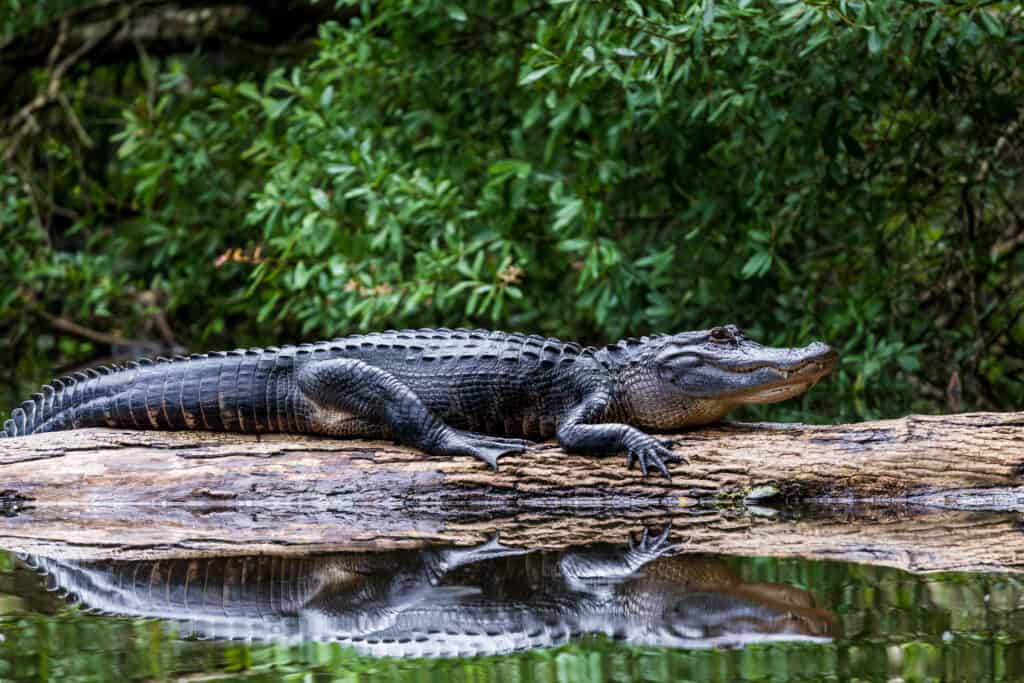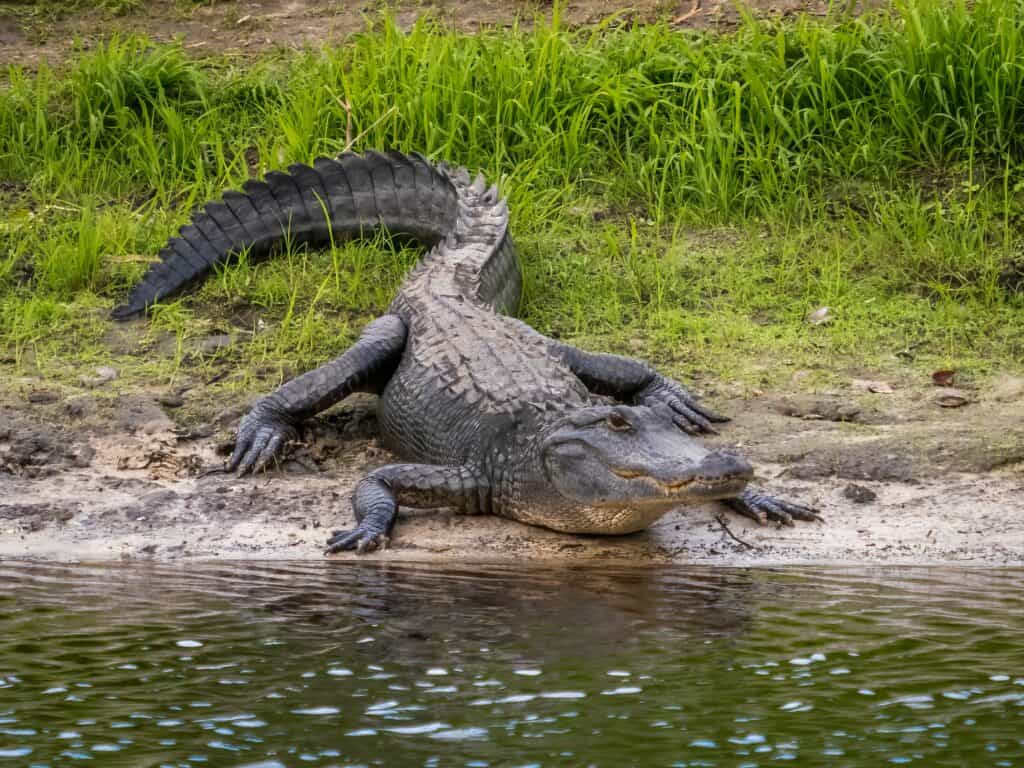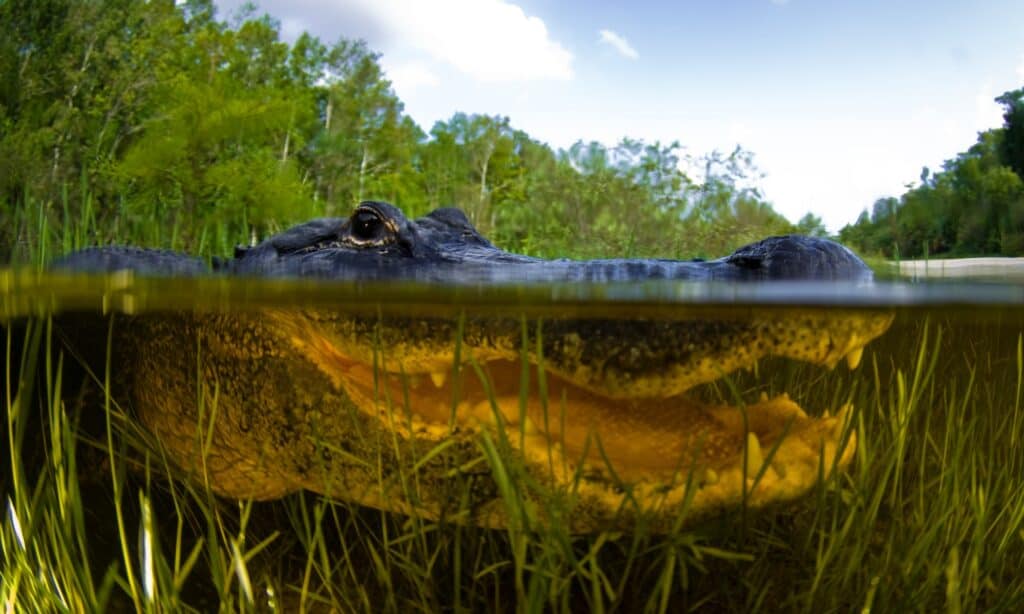Alligators might not be the largest members of the Crocodilia order of animals, but they’re certainly some of the most famous. These semi-aquatic reptiles live only in North America, where they’ve been present for millions of years. In fact, alligators have been around for an astounding 65 million years. In North America, they once flourished throughout much of the southeast. Today, thanks to conservation efforts, alligators can once again be found in states like Arkansas. You might be wondering: just how many alligators live in Arkansas?
We’ll discover the answer to that question here. We’ll also learn more about what makes American alligators unique and what specific challenges they’ve faced in Arkansas. Then, we’ll take a look at which U.S. state has the most alligators and learn about hunting gators in Arkansas. Finally, we’ll go over five key steps to staying safe around alligators—no matter where you are.
The American Alligator

Alligators are large scaly reptiles with long tails and short legs.
©iStock.com/Joe Pearl Photography
American alligators aren’t crocodiles, but they are closely related to crocodiles. They’re also related to the other crocodilians—gharials, caimans, and false gharials. There’s only one other type of alligator in the world, the Critically Endangered Chinese alligator. Chinese alligators live in China’s Yangtze River; there are thought to be fewer than 100 remaining individuals.
Where Can You Find Alligators?
Alligators live only in the coastal lowlands of the southeastern United States. Their populations are densest in Louisiana and Florida and lowest in Oklahoma. Gators live as far north as coastal North Carolina and as far west as Texas’ Rio Grande River.
What Do Alligators Look Like?
To answer the question of how many alligators live in Arkansas, we first have to understand what a gator is. Alligators are large (up to 19 feet long) scaly reptiles with long tails and short legs. Because they spend so much time in the water, their eyes, ears, and noses are all situated on the top of their heads. Alligators tend towards dark brownish-green, with lighter-colored undersides.
But, perhaps their most distinctive feature is their teeth. Gators have up to 80 teeth at a time (they can go through 3,000 in a lifetime). When they close their mouths, their bottom teeth disappear into their gums, while their top teeth remain visible.
Alligators in Arkansas

Arkansas has a healthy estimated population of around 3,000 alligators.
©Jim Schwabel/Shutterstock.com
Thanks to conservation efforts, Arkansas has a healthy estimated population of around 3,000 alligators. These gators live only in the southern half of the state, in the lowland Delta and Gulf Coastal Plain areas. Because they’re dependent on permanent sources of fresh water to live, alligators are only found in or near lakes, streams, ponds, or wetlands. Many of Arkansas’s lakes—including Grassy Lake, Millwood Lake, and Lake Columbia, contain alligators.
Have There Always Been Alligators in Arkansas?
Now that we know how many alligators live in Arkansas, let’s find out how they got there. Alligators survived in Arkansas for millennia. But, between 1860-1960, they were nearly totally eradicated by overhunting and habitat loss. In the 1960s, federal protections of the species made it possible for scientists to actually transplant populations of gators back to Arkansas waters. The effort was so successful that Arkansas today boasts a thriving, stable population of gators.
Which State Has the Most Alligators?
As we mentioned before, Louisiana and Florida are the only states with a statewide population of gators. Florida has the second-highest population of alligators in the world, with around 1.3 million gators living in the state. But Louisiana is the undisputed king of alligators, with over two million alligators calling the state home.
Hunting Alligators in Arkansas

Arkansas’s population of alligators is stable enough to allow for a yearly hunting season.
©tswinner/Shutterstock.com
We’ve answered the question of how many alligators live in Arkansas, but are there enough gators in the state to enable hunting? In fact, there are. Arkansas’s population of alligators is stable enough to allow for a yearly hunting season. Every year, licensed and permitted hunters harvest approximately 100 gators from the swamps and lakes of Arkansas. This practice is part of the state’s management strategy and helps to keep alligator populations in check.
Alligator Safety in 5 Steps
Thinking of traveling to southern Arkansas and wondering what you can do to stay safe around alligators? Let’s take a look at the five steps you can take to ensure you have a positive alligator experience.
1. Stay Back
Alligators are wild, dangerous animals and should be treated with respect and caution. Never approach an alligator.
2. Don’t Feed
Perhaps the most important rule of all — never feed the alligators.
3. Never Harass
It might go without saying, but remember, you’re in the alligator’s home. Always treat wild animals with respect.
4. Leave Nests Alone
If you find an alligator nest, move away. Chances are Mom is close by.
5. Enjoy
Don’t forget to enjoy yourself! Seeing an alligator in the wild can be an incredible, once-in-a-lifetime experience.
Up Next:
The photo featured at the top of this post is © iStock.com/Cindy Larson
Sources
- , Available here: https://www.wlf.louisiana.gov/species/detail/american-alligator#:~:text=Louisiana%20and%20Florida%20have%20the,common%20in%20our%20coastal%20marshes
- , Available here: https://www.britannica.com/animal/alligator
- , Available here: https://www.agfc.com/en/hunting/big-game/alligator/history/
- , Available here: https://scholarworks.uark.edu/cgi/viewcontent.cgi?article=1663&context=jaas
Thank you for reading! Have some feedback for us? Contact the AZ Animals editorial team.






